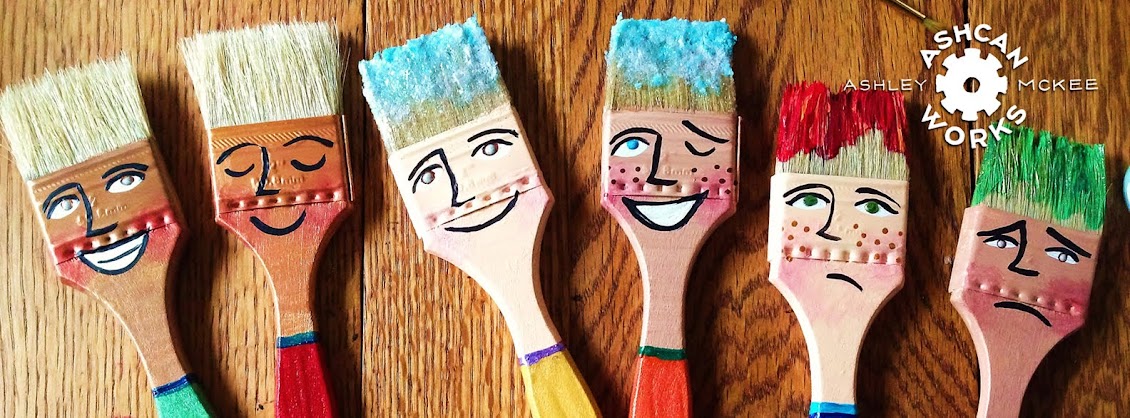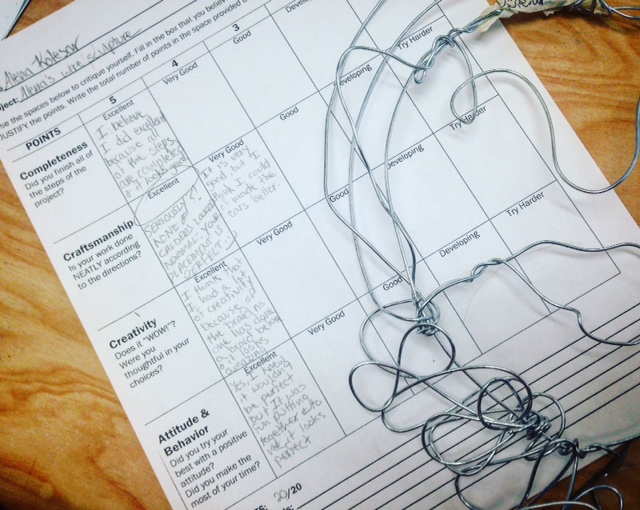6th grade is a pretty big deal. It's their last year in the elementary school (sniff, this was my first group of kindergartners!). They're the oldest kids in the school. They've learned a lot. The rest of the school kids look up to them. It's a lot of responsibility. There's more responsibility in the art room too, but in a fun kind of way. We use tools and materials we've never used before to make cool new things, like wire portraits!

Wire is a bendable, dimensional line. Before we could bend wire lines into masterpieces, we needed to understand the different types and be able to apply them to drawings. We compared and contrasted examples of contour lines (the outline and other basic visible edges; i.e. tracing your hand and adding the wrinkle lines from your palm), continuous contour lines (you can't pick up your pencil while you draw, which means you do a lot of connecting parts and retracing lines you've made), and blind contour lines (you can't look at your paper at all!). And then things got a little silly...ok, maybe a lot silly, but it was fun!

One brave volunteer agreed to come up to my stage so that I could draw her as my demo of blind contour drawing. Why do this? Why not just look at your paper? It's a great way to train your eye and your hand to work together. As you trace things with your eyes and measure how far apart and close together parts are, you attempt drawing it at the same time. It takes practice. It's not an easy thing to do, even for the art teacher who's done this before, and it's important for students to see that sometimes my best looks pretty wobbly too. Ella was a good, no wait, better than good...she was a great sport! I warned her that my drawing of her would be wiggly and strange. It might even look like her face was melting a bit, or like I was trying to draw like Picasso! She smiled and agreed to proceed! As I drew, the rest of the class watched and giggled a bit. They weren't giggling at her, but at my drawing, and not in a disrespectful way, but in a this-is-crazy-is-she-going-to-make-us-do-this kind of way. While I drew I talked to them about what I was thinking, what I was looking at, and what I was trying to do so they'd know how to approach it when it was their turn to give it a try. We critiqued it together and talked about what I did well (for not looking it really wasn't that bad!) and what needed to improve. Then it was their turn!

Students made little paper "tents" to slip over their pencils by folding a piece of copy paper twice and poking the pencil through the middle. This prevented those who were tempted to sneak a peek at their drawing from doing just that! Aren't you supposed to look at your paper?! Most of the time I'd say yes, but we were practicing blind contour drawings. This activity trains your eyes and hands to draw together to improve your skills! No peeking!
Students looked in double sided mirrors to do a blind contour self-portrait. The first drawings were a bit rushed because we couldn't wait to see how we did and how weird the drawings were. There was giggling, sharing, look at this! Then it was back to the drawing board to try it again. Rarely do first attempts look amazing, and that's ok.

The next time we met we viewed and discussed the wire sculptures of Alexander Calder, inventor of the mobile. That's right! They're not just for hanging over baby cribs, they were first created as pieces of art! Calder was a Pennsylvania artist who began creating things as a young child. His parents were artists that supported his creativity. We looked at his wire portraits and compared them to photographs of the people they represented. How did he make the eyes? How were the eyes and nose connected? What loops were used to make the nose? Were all of the mouths the same? No, so how were they different? We were looking for ideas that we could apply to our own work. With several examples to reference, we got started. The pencil tents were put away. Students were able to draw continuous line drawings of themselves with a mirror and projected examples aid them. No one approached it exactly the same way. Different eyes, mouths, noses, hair.

When the drawings were complete, students needed to learn wire and tool safety! I buy spools of fencing wire from Tractor Supply for wire projects. It's easy to store, easy to bend, and one spool can meet my needs for the year! Several students knew exactly what it was when I demoed because they have farming experience. I loved that it showed them that they could do something new with something familiar. Art is pretty awesome like that.
Students learned how to cut it from the spool without letting it all unwind into a mess. They learned various ways to manipulate the wire with needle-nosed pliers, how to take care of end bits of wire that poked out, how to anchor your wire so your face didn't move, how to attach a new piece so they could keep sculpting.
Students that finished helped those who struggled with cutting the wire. Everyone was responsible with the tools. Everyone cleaned up well.
Sometimes in art your original idea doesn't work out as planned. Most students experienced this while working on their wire portraits. The eyes they bent might be different than the eyes they drew, the mouth was totally different because they ran out of wire, they discovered a better way to make eyebrows than their reference sketch idea, a friend suggested tweaking the hair and they liked that idea better. It happens. I change my mind in the middle of my work often. We were problem solving in the thick of it and they did a great job! Creative Problem solving is a big part of making things. It's a constant in the art room.
When students were finished with their portraits I gave them a paper to critique and grade themselves with. I wanted to see how they thought they did and I wanted them to justify their thoughts. It helps me understand their thoughts, and it helps them to really pause and think about their work.
Some were surprisingly much harder on themselves than I expected. I visited each table while they worked to add my comments to their paper. Giving positive feedback is important. It feels good to know someone sees good in your work. Everybody needs that from time to time.
And when students were finished with their critiques, I collected the wire portraits!
I took advantage of an early dismissal day to hang them in the hall with a glittery new sign and can't wait for students to see them tomorrow! They look SO GOOD!!!
Teachers passing through that saw me hanging them commented on what a great job the students did. They paused to critique a few. They asked questions about the project. The kids should be so PROUD of how well they did, because I most certainly am!



















































